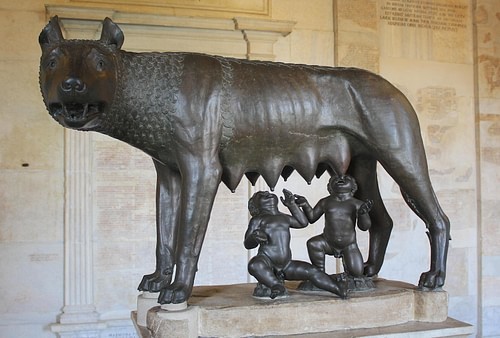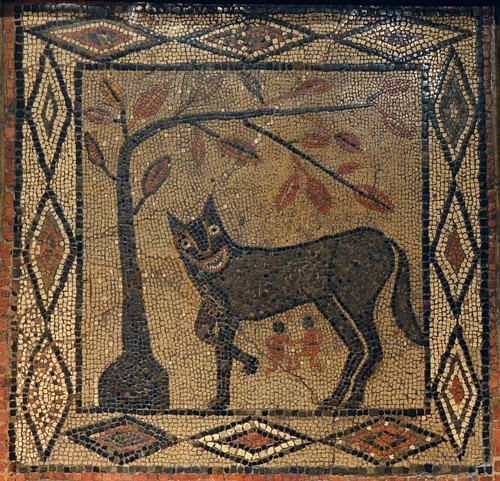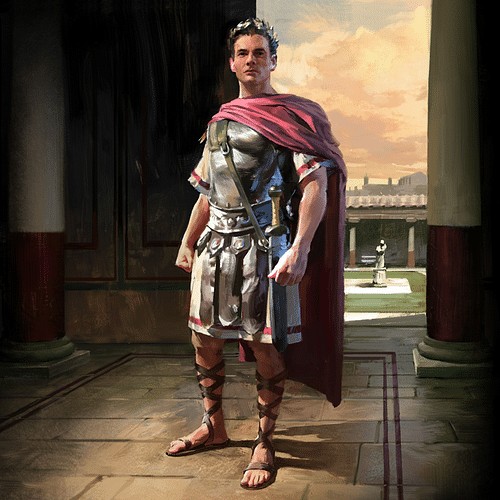Why Did Romulus Kill Remus? This question delves into the heart of Rome’s founding myth, exploring fraternal conflict and the establishment of power. At WHY.EDU.VN, we aim to provide a comprehensive understanding of this pivotal event, examining the various accounts and interpretations surrounding the fratricide that shaped the destiny of a civilization. This exploration will uncover the reasons behind Romulus’ actions, his motivations, and legacy, shedding light on the origins of Rome and its enduring impact on Western civilization. We’ll consider historical perspectives, mythological significance, and the symbolism behind the act of killing his brother.
1. The Mythological Foundation: Romulus and Remus
The story of Romulus and Remus is foundational to Roman identity, serving as both a historical account and a mythological narrative. The tale begins with their divine parentage and miraculous survival.
1.1. Divine Origins and Early Life
Born to Rhea Silvia, a Vestal Virgin, and the god Mars (or sometimes Hercules), Romulus and Remus were descendants of Aeneas, a Trojan hero who fled to Italy. Their lineage connected them to the very fabric of Roman destiny.
- Rhea Silvia’s Predicament: Rhea Silvia, forced into celibacy as a Vestal Virgin, bore the twins, leading to her imprisonment by King Amulius.
- The Twins’ Abandonment: Fearing divine retribution, Amulius ordered the twins to be cast into the Tiber River, hoping they would perish.
- Miraculous Rescue and Nurturing: The river god Tibernus intervened, guiding their basket to safety. A she-wolf, lupa, found and suckled them, symbolizing the wild and untamed origins of Rome. They were also fed by a woodpecker or picus.
- Shepherd’s Care: Eventually, the shepherd Faustulus and his wife, Acca Larentia, discovered and raised the twins, nurturing them into strong and capable young men.
1.2. The Quest for a City
As adults, Romulus and Remus yearned to establish their own city. They chose a location near the site of their rescue, but disagreement arose over the precise location.
- The Auspices Contention: Romulus favored the Palatine Hill, while Remus preferred the Aventine Hill. To resolve their dispute, they decided to consult augury, seeking divine guidance through the observation of birds.
- Differing Omens: Remus claimed to have seen six birds first, while Romulus later saw twelve. This discrepancy led to further conflict, with each brother asserting his claim to divine favor.
- Escalating Tensions: The disagreement escalated into a heated quarrel, fueled by ambition and a desire to establish dominance.
2. The Fratricide: Accounts and Interpretations
The death of Remus is a central event in the founding myth, laden with symbolism and subject to various interpretations. This act of fratricide shaped the narrative of Rome’s origin and its future.
2.1. The Fatal Boundary
Romulus, determined to establish his city, began constructing walls around the Palatine Hill. Remus, in a display of defiance and mockery, jumped over the incomplete walls.
- Breach of Boundaries: Remus’ act was seen as a violation of the sacred boundary of the nascent city, a challenge to Romulus’ authority and a rejection of his vision.
- Symbolic Transgression: This transgression represented a disregard for the laws and order that Romulus sought to establish, undermining the very foundation of the new city.
2.2. Varying Accounts of Remus’ Death
The circumstances surrounding Remus’ death vary depending on the source, contributing to the myth’s complexity and interpretative possibilities.
- Livy’s Account: The historian Livy suggests that Remus died shortly after jumping over the wall, attributing his death to divine will, a sign of Rome’s destiny.
- St. Jerome’s Version: St. Jerome recounts that Remus was killed by one of Romulus’ supporters, either Fabius or Celer, who struck him with a spade in response to his mockery.
- The Dominant Narrative: The most prevalent version asserts that Romulus himself killed Remus in a fit of rage, defending the sanctity of his city and asserting his authority.
2.3. Romulus’ Motivation and Aftermath
Regardless of the exact circumstances, Romulus’ actions were driven by a combination of factors, including ambition, the need to establish order, and a belief in his own destiny.
- Assertion of Authority: Romulus’ actions were a decisive assertion of his authority, demonstrating his willingness to defend his vision for Rome, even at the cost of his brother’s life.
- Mourning and Regret: Despite the act of fratricide, Romulus mourned Remus’ death, bestowing upon him full funeral honors, indicating a sense of remorse and familial love.
- Founding of Rome: Romulus proceeded to found the city, naming it Roma after himself, solidifying his legacy as the founder of one of history’s most influential empires.
3. Symbolism and Interpretations
The story of Romulus and Remus is rich in symbolism, offering various interpretations of the fratricide and its significance to Roman identity.
3.1. The Price of Civilization
The killing of Remus can be interpreted as the necessary price of civilization, a sacrifice required to establish order and defend against chaos.
- Order vs. Chaos: Remus’ actions represent the forces of chaos and disorder, while Romulus embodies the principles of law and structure.
- Sacrifice for the Greater Good: The fratricide symbolizes the sacrifices required to build a stable society, where individual desires must sometimes be subordinated to the collective good.
3.2. The Dangers of Ambition
The story also serves as a cautionary tale about the dangers of unchecked ambition and the destructive potential of fraternal rivalry.
- Fraternal Conflict: The conflict between Romulus and Remus highlights the destructive nature of rivalry, even between those with the closest bonds.
- Hubris and Tragedy: Their ambition and desire for power ultimately lead to tragedy, demonstrating the potential consequences of unchecked ego.
3.3. The Inevitability of Fate
Some interpretations suggest that the fratricide was an inevitable event, predestined by fate to shape the course of Roman history.
- Divine Will: The varying accounts of Remus’ death, including divine intervention, suggest that the event was part of a larger plan, guided by the gods.
- Rome’s Destiny: The fratricide, in this view, was a necessary step in fulfilling Rome’s destiny, a pivotal moment that set the stage for its future greatness.
4. Historical Perspectives and Debate
While the story of Romulus and Remus is primarily mythological, it has been subject to historical analysis and debate, with scholars questioning the historicity of the events and their symbolic significance.
4.1. Historicity of the Myth
Historians debate the extent to which the story of Romulus and Remus reflects actual historical events, with many viewing it as a symbolic narrative rather than a literal account.
- Lack of Contemporary Evidence: There is no contemporary evidence to support the story of Romulus and Remus, leading many scholars to view it as a later invention.
- Symbolic Representation: The myth likely evolved over time, incorporating various cultural and political themes to legitimize Roman power and identity.
4.2. Archaeological Evidence
Archaeological discoveries have provided some insights into the early development of Rome, but they do not definitively confirm or deny the story of Romulus and Remus.
- Early Settlements: Archaeological evidence suggests that the Palatine Hill was inhabited as early as the 10th century BCE, indicating the presence of early settlements in the area.
- Fortifications and Walls: The remains of early fortifications and walls on the Palatine Hill provide some support for the idea that Romulus may have constructed defensive structures, although their connection to the myth is speculative.
4.3. Alternative Theories
Some scholars propose alternative theories about the origins of Rome, suggesting that it may have been founded by a coalition of different groups rather than by a single individual.
- Synoecism: The theory of synoecism suggests that Rome may have been formed through the gradual unification of several smaller settlements, rather than through a single act of foundation.
- Multiple Founders: Some scholars argue that the story of Romulus and Remus may represent a composite of different founding figures, each associated with a different aspect of Roman identity.
5. The Legacy of Romulus and Remus
The story of Romulus and Remus has had a lasting impact on Roman culture and Western civilization, shaping ideas about leadership, identity, and the nature of power.
5.1. Symbol of Roman Identity
Romulus and Remus became powerful symbols of Roman identity, representing the city’s origins, its strength, and its destiny.
- Founding Myth: Their story provided a unifying narrative for the Roman people, connecting them to a shared past and a common purpose.
- Artistic Representation: Romulus and Remus were frequently depicted in art and literature, serving as reminders of Rome’s glorious beginnings.
5.2. Influence on Political Thought
The story of Romulus and Remus has influenced political thought, particularly in discussions about the legitimacy of power and the role of leadership.
- Justification of Authority: Romulus’ actions have been used to justify the use of force in establishing and maintaining order, particularly in times of crisis.
- Critique of Tyranny: The story has also been interpreted as a warning against the dangers of tyranny and the abuse of power, highlighting the importance of justice and restraint.
5.3. Enduring Cultural Impact
The story of Romulus and Remus continues to resonate in contemporary culture, inspiring works of art, literature, and film.
- Artistic Interpretations: Artists continue to reinterpret the myth, exploring its themes of fratricide, ambition, and the founding of civilization.
- Modern Relevance: The story remains relevant today, offering insights into the complexities of power, the challenges of leadership, and the enduring human fascination with origins.
6. Exploring the Question with WHY.EDU.VN
Understanding why Romulus killed Remus requires examining the historical context, mythological significance, and the various interpretations of this pivotal event.
6.1. Deep Dives into Historical Narratives
WHY.EDU.VN offers comprehensive resources to explore historical narratives, providing detailed accounts and analyses of significant events.
- Expert Analysis: Access articles and insights from historians and experts on Roman history and mythology.
- Contextual Understanding: Gain a deeper understanding of the political, social, and cultural factors that shaped the story of Romulus and Remus.
6.2. Unpacking Mythological Elements
Our platform helps you unpack the mythological elements of the story, revealing the symbolic meanings and cultural significance embedded within the narrative.
- Symbolism Exploration: Discover the layers of symbolism in the story, from the she-wolf to the act of fratricide, and their relevance to Roman identity.
- Comparative Mythology: Compare the myth of Romulus and Remus with other foundation myths from around the world, identifying common themes and unique elements.
6.3. Diverse Interpretations and Analyses
WHY.EDU.VN provides a platform for exploring diverse interpretations and analyses, encouraging critical thinking and a nuanced understanding of historical events.
- Scholarly Debates: Review scholarly debates and different perspectives on the historicity and meaning of the Romulus and Remus myth.
- Open Discussions: Participate in open discussions and forums to share your own insights and interpretations with others.
7. Key Takeaways and Reflections
The story of Romulus and Remus provides valuable insights into the complexities of power, the nature of leadership, and the enduring human fascination with origins.
7.1. The Complexity of Power
The fratricide highlights the complex and often brutal nature of power, demonstrating the sacrifices and compromises required to establish and maintain authority.
- Moral Dilemmas: The story forces us to confront the moral dilemmas associated with leadership, particularly in times of crisis.
- The Use of Force: It raises questions about the legitimacy of using force to achieve political ends, and the potential consequences of such actions.
7.2. Leadership and Responsibility
Romulus’ actions serve as a reminder of the heavy responsibilities that come with leadership, and the need for leaders to act with wisdom and restraint.
- Decision-Making: The story underscores the importance of careful decision-making, particularly in situations where the stakes are high.
- Accountability: It highlights the need for leaders to be accountable for their actions, and to consider the potential consequences of their choices.
7.3. The Enduring Fascination with Origins
The enduring popularity of the Romulus and Remus myth reflects the human fascination with origins, and the desire to understand the roots of our identity.
- Cultural Identity: The story provides a sense of shared identity, connecting us to a common past and a collective narrative.
- Historical Context: It reminds us of the importance of understanding history, and of learning from the past to shape a better future.
8. Exploring Related Questions on WHY.EDU.VN
If you found this exploration of why Romulus killed Remus engaging, WHY.EDU.VN offers a wealth of related content to further satisfy your curiosity.
8.1. The Significance of the She-Wolf in Roman Mythology
Explore the symbolism and cultural significance of the she-wolf in Roman mythology, and its connection to the founding of Rome.
8.2. The Role of Augury in Roman Decision-Making
Learn about the practice of augury and its role in Roman decision-making, and how it influenced political and military strategy.
8.3. The Influence of the Aeneid on Roman Identity
Discover the influence of Virgil’s Aeneid on Roman identity, and how it shaped the narrative of Rome’s origins and its destiny.
9. Call to Action: Dive Deeper with WHY.EDU.VN
Do you have more questions about Roman history, mythology, or any other topic that sparks your curiosity? Visit WHY.EDU.VN to explore a world of knowledge and connect with experts who can provide the answers you seek.
9.1. Ask Your Questions
Post your questions on our platform and receive detailed, expert-backed answers from our community of scholars and enthusiasts.
9.2. Explore Our Extensive Database
Browse our extensive database of articles, videos, and resources to discover new insights and expand your knowledge.
9.3. Engage with Experts
Engage with experts in various fields, participate in discussions, and share your own perspectives on the topics that interest you.
10. Frequently Asked Questions (FAQ)
Here are some frequently asked questions related to the story of Romulus and Remus:
| Question | Answer |
|---|---|
| 1. Who were Romulus and Remus? | Romulus and Remus were the twin brothers who, according to Roman mythology, founded the city of Rome in 753 BCE. |
| 2. Who were their parents? | Their mother was Rhea Silvia, a Vestal Virgin, and their father was the god Mars (or in some accounts, the demi-god Hercules). |
| 3. Why were they abandoned as babies? | King Amulius, who had usurped the throne from their grandfather, ordered them to be abandoned in the Tiber River to prevent them from claiming the throne later in life. |
| 4. How did they survive? | They were rescued by a she-wolf (lupa) who suckled them until they were found by a shepherd named Faustulus, who raised them with his wife, Acca Larentia. |
| 5. Why did Romulus and Remus argue? | They argued over the location of their new city; Romulus wanted to build it on the Palatine Hill, while Remus preferred the Aventine Hill. |
| 6. What is augury, and how did it play a role in their dispute? | Augury is a form of divination in which birds are observed to determine the will of the gods. Romulus and Remus used augury to try to decide which hill to build their city on. |
| 7. Why did Remus jump over Romulus’ wall? | Remus jumped over Romulus’ wall as a sign of mockery and defiance, challenging Romulus’ authority and the sanctity of his city. |
| 8. How did Remus die? | The circumstances of Remus’ death vary depending on the source. Some say he was killed by Romulus in a fit of rage, while others claim he died shortly after jumping over the wall. |
| 9. What happened after Remus’ death? | Romulus founded the city of Rome on the Palatine Hill and became its first king. |
| 10. What is the significance of the Romulus and Remus story today? | The story of Romulus and Remus remains a powerful symbol of Roman identity, representing the city’s origins, its strength, and its enduring legacy. |




Contact Us
For more information and to explore further, visit our website at WHY.EDU.VN. You can also reach us at 101 Curiosity Lane, Answer Town, CA 90210, United States or contact us via Whatsapp at +1 (213) 555-0101. Let why.edu.vn be your guide in the quest for knowledge and understanding.